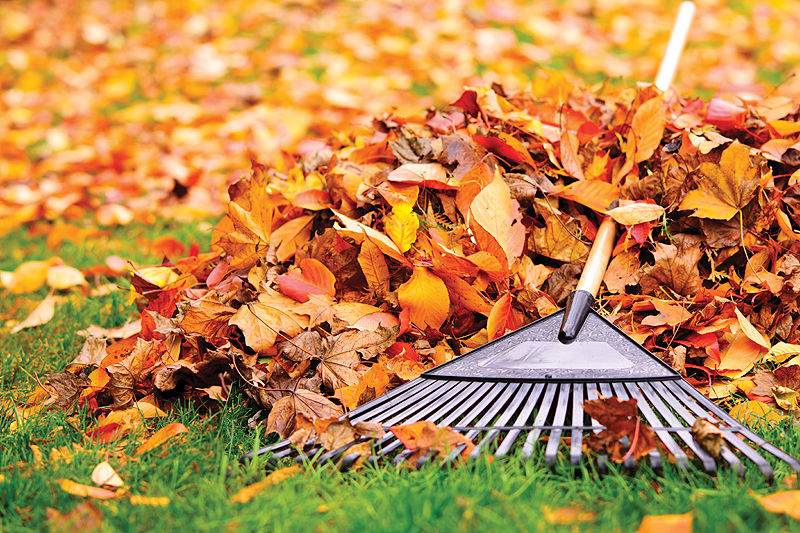Winter is just around the corner. After all of the relentless mowing, harvesting and canning, we can get a little burned out on yardwork. However, don’t give up yet. Fall is an important time to set the yard up for healthy plants next year. The lawn, vegetable garden, shade trees and perennial beds can be even more beautiful with proper fall maintenance. Consider these tips to keep up your gardening momentum.
Lawns
You have probably already noticed that the cooler weather has helped your lawn green back up after summer heat, and you are still mowing just as often, if not more. Starting in October, gradually lower your mower height each time you mow.
The goal is to get the grass length to 1 ½ – 2 inches without scalping the lawn. Short grass does not matt under snow cover, and therefore is less susceptible to snow mold and other fungi. Consider mowing your fallen leaves without bagging them to add organic matter for a healthier lawn. If you have heavy thatch or compacted soil, consider core aerating your lawn this fall.
Fall is also one of the most important times for lawn fertilization and weed control. Applying high nitrogen, fast release fertilizer in November will give your lawn a great head start for next year. Fall and spring are the two times of year when herbicides are most effective. Weeds are already beginning to transport carbon to their roots for winter storage, making them more susceptible to herbicide treatment.
Vegetable Gardens
Now is the time to prepare your vegetable garden so you are ready to plant next spring. If you currently have a vegetable garden, the cleanup is very important. Sanitation is key to a healthy garden. Pull out or cut all your vegetable plants to the base. Remove all leaf debris or fallen fruits. You can compost your spent vegetable plants as long as they are not diseased. Weed removal is also very important. Insect pests often overwinter on several weed species. Keep the pests out by keeping the weeds out.
Vegetables need nutrient-rich, high-organic soil. Whether you are planning to start a vegetable garden for the first time or you are planning to plant again next spring, fall is a great time to add nutrients in the form of organic matter. Grass clippings, raked leaves, compost or manure are all things you can spread over your garden so it is ready for planting in the spring.
Spice up your garden with garlic, as it is one of the easiest, rewarding vegetables to plant. Simply plant the bulbs in October, watch them come up in the spring, fertilize, water and you are ready to harvest in July. Enjoy cooking with garlic all winter long. If you save a handful of garlic cloves each year, you will have garlic forever.
Trees
All trees, especially evergreens and newly planted trees, should have one last deep watering before the snow flies. Evergreens continue to transpire during the wintertime, so it is important that they have access to deep moisture, especially when we have dry winters. You can run an open hose to your tree, periodically moving it every 15 minutes around the dripline. Alternatively, you can use a hose-attachable sprinkler head. Adjust it to cover the entire dripline of the tree, and let it run for a minimum of 40 minutes. Pruning is not ideal in the fall – it is best to wait until spring.
Perennial Beds
Most perennials need to be cut back to the ground in the fall. Of course, there are always the “stubborn” perennials that just keep blooming into November. By the time they are dormant, you are out cutting them back during snowfall. Luckily, not all perennials require cutting back in the fall. Hostas and Daylillies can be left for spring. Ornamental grasses are also saved for an early spring chore. Though they may be cut back in the fall, ornamental grasses provide decorative value in the winter landscape as well as seeds and habitat for birds.
Cutting back perennials in the fall produces more debris than most compost bins can take. For small-scale composting, large plant debris must be chopped into 2 to 3-inch pieces, or it will take an extra month or two to break down. Finely chopping spent perennials is a lot of work. A green waste bin is ideal. The easiest technique is to go through the perennial bed with a pair of sharpened hedge shears, cut everything at once, then rake the debris onto a pile.
If your perennial bed lacks early spring color, now is the time to plant spring bulbs such as tulips, daffodils, crocus, hyacinth and allium. Any of these, mixed or in mass, will give you a long-lasting variety of spring color. Bulbs are generally planted three times deeper than their diameter; therefore, most bulbs will need to be planted between 5 and 7 inches deep.
Happy fall, and keep up the gardening momentum!
HOME & GARDEN | Four areas of focus for fall yard cleanup

leaves
